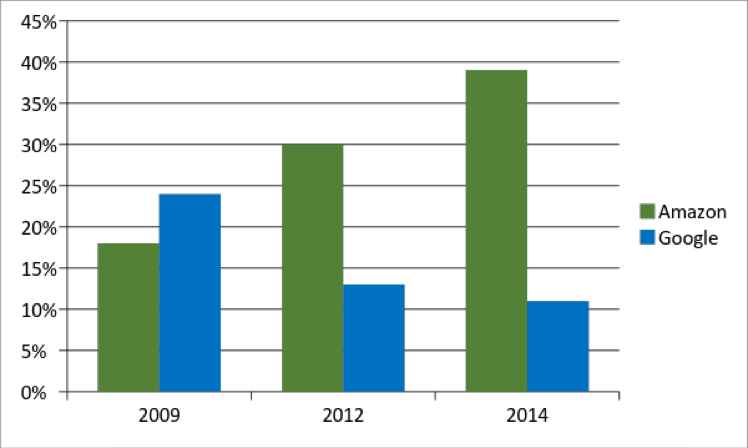In our increasingly online world, the road to book marketing success begins more often on the screens of online bookstores than between an aisle of books. These virtual stores continue to displace the shelves and point-of-purchase displays in a physical bookstore, allowing any publisher to reach readers. But that still doesn’t guarantee readers will find your book. So, short of advertising or being famous, how do we improve book discovery? By optimizing the book’s online store listing just as one would optimize a website.
Optimizing metadata and its importance for search engines
The phrase Search Engine Optimization, or SEO, is practically synonymous with Google and positioning one’s website to show up on the first page of results when someone searches for a specific word or phrase. What does this have to do with authors and publishers? The reality is that there are lots and lots of search engines, including the search engines that help you find products in online stores, the largest of which is Amazon.
In 2009, 24 percent of US online shoppers began researching their purchases on Google, while 18 percent started at Amazon. Contrast this with 2014 when Google provided just 11 percent of all product searches and Amazon jumped to 39 percent. (Source: Forrester Research)

Amazon dwarfs Google when it comes to product search
The basics of book sales metadata
Your book’s title, description, categories, keywords and other metadata elements are used by online stores to help their shoppers find books. Each store has algorithms—computer software that follows step-by-step procedures to evaluate shopping behavior and anticipate interests—and algorithms respond to metadata. The most powerful of these for you, the publisher, and the ones that you can modify at will, are categories and keywords.
Every store is a little different
Each online store has a slightly different set of features, capabilities and metadata options to help publishers optimize a book’s discoverability. Adding to the complexity (or is that opportunity?), categories in the print book store section can differ from the eBook store section, as is the case with Amazon. It is equally important to note that there is no standard, official list of categories because online stores can choose to organize their virtual shelves based on their retailing intelligence.
The good news for independent publishers is that there are two primary category heading classifications in use by the major retailers: Amazon’s and the Book Industry Standards and Communications (BISAC) Subject Headings. Both heading lists can and do change over time but as noted, this is a metadata field that can be updated by the publisher as needed. Support for keywords, however, are unique to each store and in fact not every online store supports keywords.
To illustrate, here is a sample of SEO-related book sales metadata and how support differs between six major US online book sellers and distributors with self-service publishing portals.

* Both CreateSpace and IngramSpark are printers and distributors, and in the case of IngramSpark, they also distribute eBooks to other retailers. Keep in mind that the metadata they collect may or may not be accepted by a retailer that chooses to add a book to their online store.
Categories help readers find books
Categories allow shoppers to drill down within ever finer classifications of a topic. For example, a top level BISAC Subject Heading such as ARCHITECTURE has 38 subcategories; from Adaptive Reuse & Renovation, to Buildings, to Urban & Land Use Planning. Within several of these subcategories, such as Buildings, you can have sub-subcategories, or 3rd level categories, like this:
ARCHITECTURE / Buildings / Landmarks & Monuments
Even though this is three levels deep, it is still defined as a single category. Moreover, your book is, by definition, available in every parent category. It is found in Architecture and Architecture/Buildings.
Always select the narrowest (deepest) category appropriate for a book. Why? Because that is how some shoppers look for books. A second reason is that the narrower the category, the greater your book’s chance of rising to the top of that category, with the ultimate objective of becoming a best seller.
Of course, this is not to suggest you assign a book to an unrelated category because doing so could result in one of two potential problems. First, your targeted reader may never find the book. Or two, the reader may be disappointed and angry about being misled, with the unhappy result that the book gets a bad review and/or the buyer returns it for a refund.
Finding and choosing categories
Each of the stores in the table above have drop down menus where you make your selection(s). You can also visit the BISAC Subject Headings . Once you have a list of possible categories, visit the appropriate store and look at the books in each category to ensure that your book fits with the other books.
Keywords
While every store has categories, not every store provides support for keywords, as noted above. Even when they do provide support, keywords are unique to each store that supports them.
Selecting the keywords, also called search terms or phrases because they involve two or more words, is as much an art as it is a science. The simple instructions are to visit each online book store and start typing a word you think people would use to find your book. (Be sure you are in the book section for that store.) Do books like yours show up? It can be a tedious and confounding task but again, getting this right could have a profoundly positive impact on sales.
Again, keywords (like categories) are most effective when they are customized for each store. If you use an aggregator to add your book to a store, and assuming the aggregator even supports keywords, the keywords you enter will probably not be as effective as identifying keywords specific to each store.
Don’t stop with book metadata
It turns out that there are many things an author/publisher can control to help their book be more visible on Amazon. The good news is that your skills and these techniques can also be applied to other bookstores, social networks, and industry databases, not to mention traditional search engines like Google, Yahoo, and Bing.
The trick is to adopt good metadata work habits. Here are my top three:
- Keep a record of everything. For example, I use a single Word file to keep track of all my bios (David Wogahn Bios.docx). This helps enforce the next two habits.
- Be accurate. If your book title uses a hyphenated word, duplicate this everywhere you write the title.
- Be consistent. Information entered in one profile or listing should match other listings.

DAVID WOGAHN is president of AuthorImprints, a professional self-publishing services company. Wogahn has helped more than 100 authors and businesses establish their own publishing imprints, resulting in the successful publication of 250 books…and counting. He is the author of Register Your Book: The Essential Guide to ISBNs, Barcodes, Copyright and LCCNs, LinkedIn’s Lynda.com course Distributing and Marketing eBooks, and is a speaker for the Independent Book Publisher Association’s (IBPA) Publishing University.
Learn more at http://www.authorimprints.com or contact Wogahn at davidw@authorimprints.com or by phone at (877) 735-5269.
EDITOR’S NOTE: City Book Review also provides SEO services to authors.

